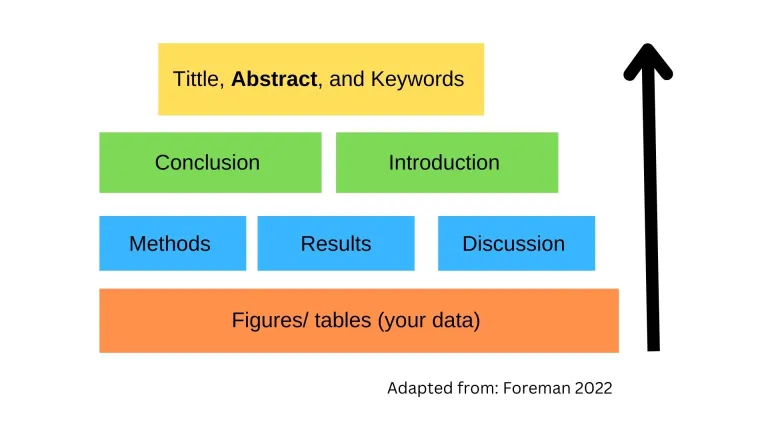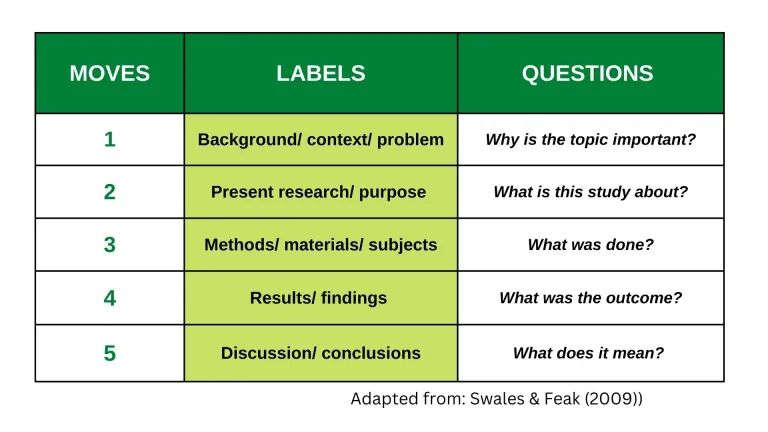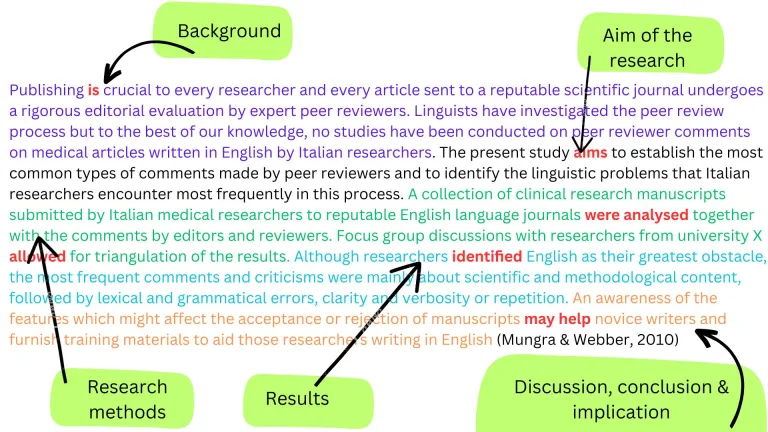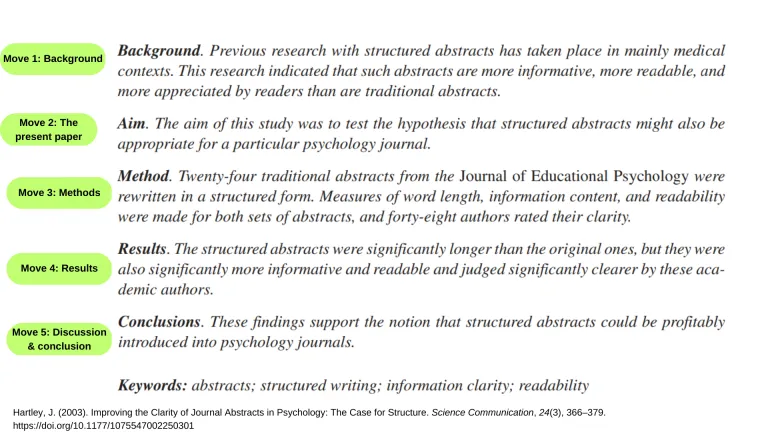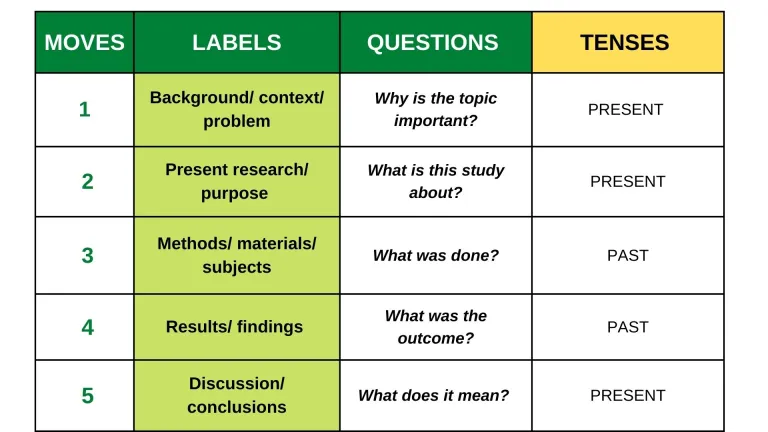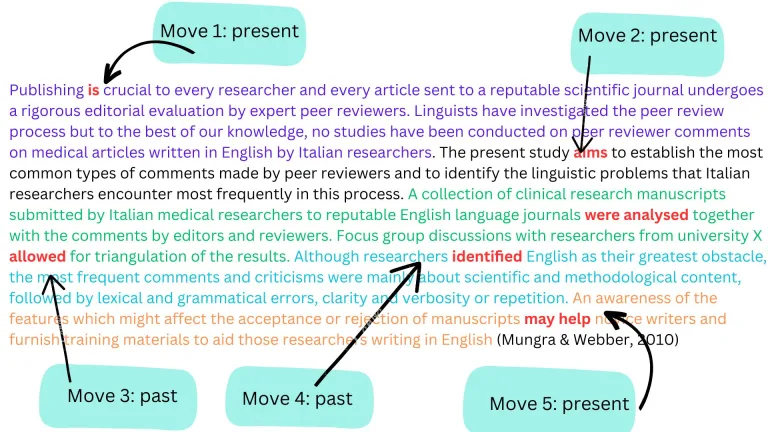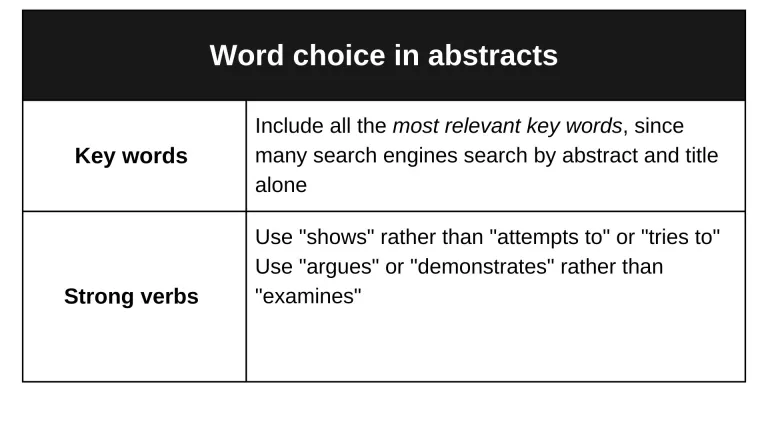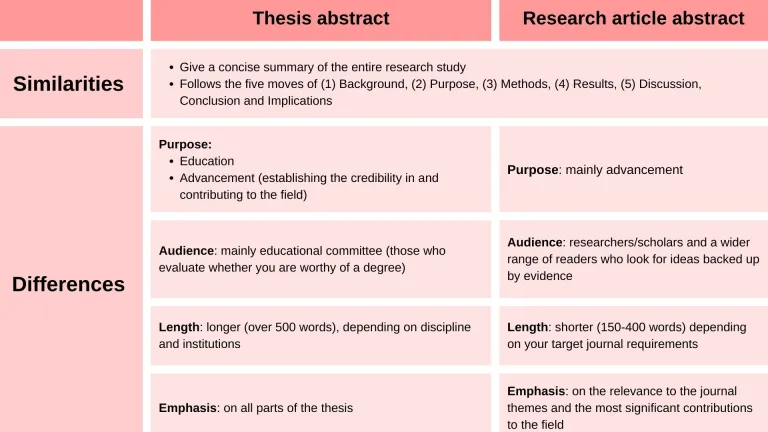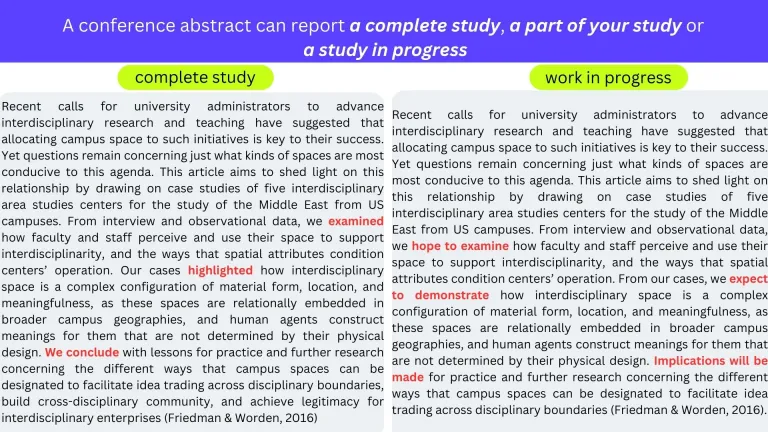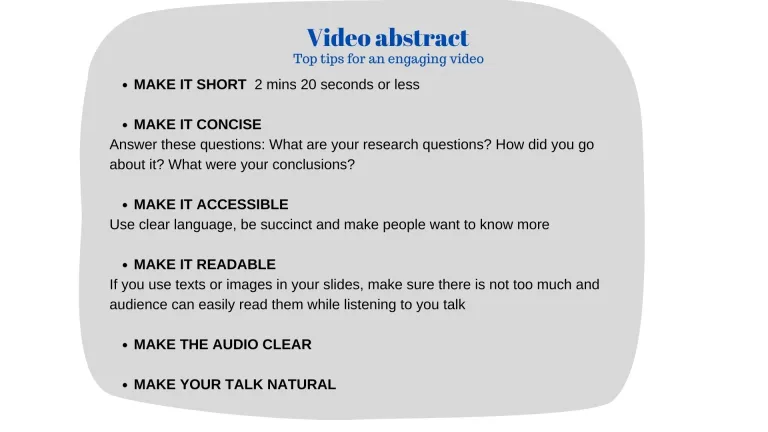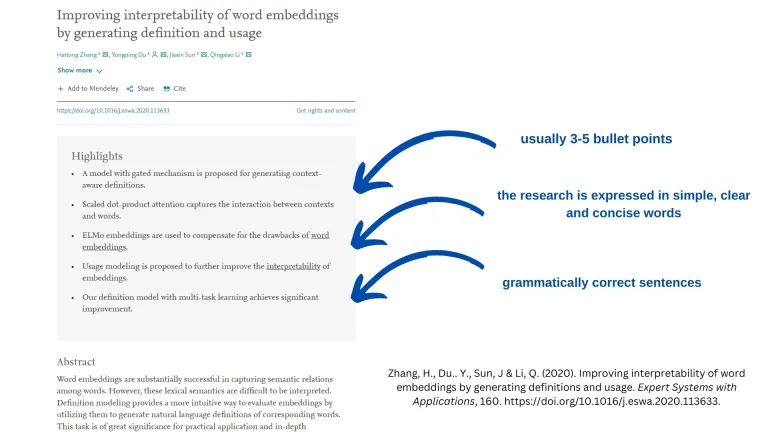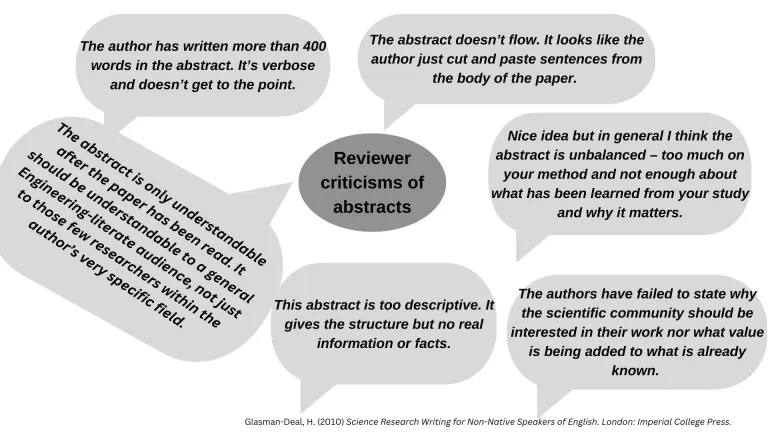An abstract is a condensed version of your article; a distillation of the most important information (Belcher, 2019, p. 93).
This page will help you to:
- understand the purpose and importance of an abstract
- plan an abstract
- structure and write different types of abstracts for your thesis and publication.
Download this summary sheet for your own reference.
Introduction to abstracts
This section will introduce the abstract and outline their purpose and importance.
Self evaluation
Before you continue, reflect on your previous writing experiences and the feedback you have received. How would you rate your ability in the following skills? Rate your ability from ‘good’ to ‘needs development’.
Reflect on your answers. Congratulations if you feel confident about your skills. You may find it helpful to review the materials on this page to confirm your knowledge and possibly learn more. Don't worry if you don't feel confident. Work through these materials to build your skills.
What is an abstract?
An abstract gives an overview of your entire project and usually answers these questions:
What is your research about?
Why is it important?
How did you do it?
What did you find?
Why are your findings important?
An abstract is generally brief: about 150-300 words for a journal article and about 500 words for a thesis. Requirements will vary depending on the type of abstract, the journal, the institution or the discipline.
In some disciplines, an abstract is divided into several short sections such as Background; Methodology; Findings; Implications.
What is the purpose of an abstract?
The abstract aims to:
give readers a summary of a research study
help readers decide whether the research is relevant before they read the full paper
provide a roadmap for readers who wish to read the whole article or thesis.
It therefore functions as a stand-alone mini text, a screening device and a preview (Huckin, 2001).
Why is writing a good abstract important?
The abstract is generally the first thing a reader will look at although the abstract is the last part of a dissertation to be written (Cooley & Lewkowicz, 2003, p. 112).
Explore the interactive image below to understand the many reasons why writing a good abstract is important. Click the (+) in the image for more information about each point.
Planning an abstract
This section outlines the process of planning an abstract. This includes understanding different types of abstract, knowing when to start writing and a step-by-step process for writing an abstract.
Understanding different types of abstracts
The type or style of an abstract depends on several considerations. For example, they may be structured or unstructured depending on the discipline. More information can be found in Structuring an abstract.
Different types of abstracts are required depending on where you want to publish. These include thesis abstracts, research article abstracts, conference abstracts and so on. More information can be found in Different types of abstracts.
Knowing when to start writing an abstract
To know when to write an abstract, it is necessary to understand the process of building an article.
The sequence for writing an article is different to the sequence for reading it. When writing, you may:
- produce your tables and figures which convey the results of your research and help you form an argument.
- describe your methods and results and then discuss the results
- write the conclusion and introduction and ensure they are consistent with each other
- produce the abstract once the study is complete.
A complete abstract that summarises the article, tells a coherent story, states the argument and reveals the most significant findings can only be written after all the steps in the writing process are complete.
However, you should START drafting an abstract EARLY as the task is "the anchor and catalyst for the framing and reframing of writing goals (Liner et al, 2014, p. 223). You can draft a preliminary abstract of a paper as a way of beginning to think about the topic and as a device for organising your ideas. Throughout your research project, you are likely to modify the abstract because the abstract also serves as a diagnostic tool (Belcher, 2019). If you can't write some parts in your abstract, it may mean your research does not yet have a clear focus.
Writing an abstract
This section introduces you to the structure of an abstract in a thesis and a journal article. It also provides you with different ways to organise the abstract. In writing an abstract, it is important to be clear about these following points:
- Is it a conference abstract, a thesis abstract or a research article abstract?
- What is the word limit?
- Is it a structured or an unstructured abstract?
Key components of a good abstract
A good abstract should:
summarise the article or thesis
tell a story
state the argument and a claim for the significance of that argument
reveal the most valuable findings
state the methods briefly
use strong verbs, not vague ones
include all the most relevant keywords.
(Belcher, 2019, p. 83)
Structuring an abstract
To ensure your abstract includes the key components listed above, it is recommended that you follow these fives moves in this typical order:
Let's look at two examples
Example 1:
Example 2:
The structure of an abstract varies. For example, not all abstracts include five moves and writing styles vary across disciplines. Of the moves, moves 2, 3 and 4 are usually considered essential.
You should analyse examples in your discipline and read the instructions for authors from your target journal carefully.
The language of abstracts
Being concise
The most important language feature of abstracts is that they are concise. Every word in the abstract has been chosen because it is necessary and performs a function. To learn more, visit the Academic Style in Writing page and do the practice tasks in Being concise.
Tenses
Present and past tenses are mainly used in abstracts, as illustrated below.
Look at this example:
Read this abstract and click on the correct verb choices.
Word choice:
Your abstract needs to be concise so choice of words is important. A good abstract needs to include key words and strong verbs.
Opening sentences to engage readers:
Writing the first sentence in an abstract can be challenging. Here are four basic types of opening sentences based on Swales and Feak (2009) that may help you.
Being a text detective
To ensure you make appropriate language choices in your abstracts, pay close attention to the language used in published abstracts in your discipline. Think of yourself as a text detective.
Learn more about this by visiting Academic Style in Writing and exploring the abstracts in Being a text detective.
Different types of abstracts
This section introduces you to the different types of abstract you may need to write.
The thesis abstract vs. the research article abstract
The table below compares a thesis abstract and a research article abstract .
The conference abstract
A conference abstract is normally a standalone abstract ranging from 100 to 500 words, depending on the conference. It is designed to help conference organisers decide whether they would like your paper to be presented at the conference and attendees decide whether they would like to attend your presentation.
A conference abstract describes the topic you would like to present at the conference. It can report a complete study, a part of your study or a study that is in progress (a promissory abstract).
Let's look at the examples below:
It is very important that you read the conference instructions carefully. Here are points to consider when preparing to write a conference abstract.
When is the submission date? How much time do you have to write the abstract?
What is the acceptance rate of the conference?
What is the word limit?
Is this a promissory abstract? ( a study in progress)
What is the conference theme and sub-themes?
Graphical or visual abstracts
A graphical abstract is a single, visual summary of the main findings of an article, allowing readers to easily identify the article's main message. It does not take the place of a written abstract but complements your written abstract.
You can communicate your research in different ways through graphical abstracts:
Flow diagrams use simple shapes such as shapes, arrows and crosses to describe the process.
Visual representations use models to bring a particular study into the context.
Graphs, charts and images can capture the main research findings.
Let's look at some examples of graphical abstracts:
Video abstract
A video abstract introduces readers to your article and emphasises why they should read your work. The video focuses on
- What question(s) did you want to answer with your research?
- How did you go about it?
- What conclusions did you come to?
Your video should make people want to know more. Here are the top tips for making your video abstract engaging:
You can find examples of video abstracts on theTaylor and Francis academic publisher site here.
Highlights vs. abstracts
Highlights are the ‘elevator pitch’ of your article. They are the three to five bullet points that will help increase the discoverability of your article via search engines.
They capture the novel results of your research as well as new methods that were used during the study (Elsevier, 2023). In other words, they communicate the core findings, convey the essence, and demonstrate the distinctiveness of your research.
Each highlight usually does not exceed 85 characters, including spaces, so it should be very concise.
When you know which journal you want to publish in, read articles from the journal as well as the instructions for authors to gain an understanding of whether highlights are required and how they are written.
Below is an example of highlights.
More information on highlights can be found on the Elsevier academic publishing page here.
Over to you: draft your abstract
Apply what you have learned to your own abstracts.
Working on your abstract
Use this template to plan and draft your abstract.
The template will help you gain an overview of the five moves including the background, aim of your research, research method, main findings, discussion and conclusion. You can download it and save it as a Word document once you have finished.
Next steps
Use these three tips to improve your draft.
Tip 1
Read these comments made by abstract reviewers. Have you avoided these pitfalls in your own abstract?
Tip 2 Locate and read the author instructions for your target journal or for a conference you would like to attend. Take an abstract you have written previously and practise tailoring it to meet the reviewers' requirements.
|
|
Tip 3 Exchange drafts with a peer.
|
Does the abstract:
|
Reflect on your learning
Reflect on your learning
1 | Revisit the self-analysis quiz at the top of the page. How would you rate your skills now? |
2 | Remember that writing is a process and mistakes aren't a bad thing. They are a normal part of learning and can help you to improve. |
If you would like more support, visit the Language and Learning Advisors page.
References
References
Belcher, W. L. (2019). Writing your journal article in twelve weeks: A guide to Academic Publishing Success. The University of Chicago Press
Blaxter, L., Hughes, C. & Tight, M. (2006). How to research. Open University Press
Chang, HW., Kanegasaki., S, Jin, F., Deng, Y., You, Z., Chang, J., Kim, D. Y., Timilshina, M., Kim, J., Lee, Y. L., Toyama-Sorimachi, N., & Tsuchiya, T. (2020). A common signaling pathway leading to degranulation in mast cells and its regulation by CCR1-ligand. Allergy, 75, 1371– 1381. https://doi.org/10.1111/all.14186
Chiricozzi, A., Talamonti, M., De Simone, C., Galluzzo, M., Gori, N., Fabbrocini, G., Marzano, A.V., Girolomoni, G., Offidani, A., Rossi, M.T., Bianchi, L., Cristaudo, A., Fierro, M.T., Stingeni, L., Pellacani, G., Argenziano, G., Patrizi, A., Pigatto, P., Romanelli, M., Savoia, P., Rubegni, P., Foti, C., Milanesi, N., Belloni Fortina, A., Bongiorno, M.R., Grieco, T., Di Nuzzo, S., Fargnoli, M.C., Carugno, A., Motolese, A., Rongioletti, F., Amerio, P., Balestri, R., Potenza, C., Micali, G., Patruno, C., Zalaudek, I., Lombardo, M., Feliciani, C., Di Nardo, L., Guarneri, F., Peris, K. (2021). Management of patients with atopic dermatitis undergoing systemic therapy during COVID-19 pandemic in Italy: Data from the DA-COVID-19 registry. Allergy, 76, 1813-1824. https://doi.org/10.1111/all.14767
Friedman, J. Z., & Worden, E, A. (2016). Creating interdisciplinary space on campus: lessons from US area studies centers. HERDSA, 35(1), 129-141. http://dx.doi.org/10.1080/07294360.2015.1128886
Huckin, T. N. (2001). Abstracting from abstracts. In M. Hewings (Ed.), Academic writing in context, Birmingham, UK; University of Birmingham Press.
Humphrey, P. (2015). English language proficiency in higher education: student conceptualisations and outcomes. [Doctoral dissertation, Griffith University]
Machi, L. A & McEvoy, B. T. (2012). The literature review: six steps to success. Corwin
Niessen, N.M., Gibson, P.G., Baines, K.J., Barker, D., Yang, I.A., Upham, J.W., Reynolds, P.N., Hodge, S., James, A.L., Jenkins, C., Peters, M.J., Marks, G.B., Baraket, M., Simpson, J.L. and Fricker, M. (2021). Sputum TNF markers are increased in neutrophilic and severe asthma and are reduced by azithromycin treatment. Allergy, 76, 2090-2101. https://doi.org/10.1111/all.14768
Phukon, J., Borah, A. J., & Gogoi, S. (2022). Transition-metal-catalyzed synthesis of spiro compounds through activation and cleavage of C-H bonds. Asian Journal of Organic Chemistry Review, 11, 1-35. https://doi.org/10.1002/ajoc.202200581
Ridley, D. (2008). The literature review: A step-by-step guide for students. SAGE Publications.
Zhao, F., Zhao, L., Wang, L., & Song, H. (2020). An ensemble discreet differential evolution for the distributed blocking flowshop scheduling with minimising makespan criterion. Expert Systems with Applications, 160, 1-21. https://doi.org/10.1016/j.eswa.2020.113678
Woods, M. G. (2021). Culture Counts: A choice modelling approach to quantifying cultural values for First Nations people [Doctoral dissertation, Charles Darwin University]. https://researchers.cdu.edu.au/en/studentTheses/culture-counts-a-choice-modelling-approach-to-quantifying-cultura
We value your opinion. Please click on the button to share your feedback on these materials. |
Did you know CDU Language and Learning Advisors offer a range of study support options?
https://www.cdu.edu.au/library/language-and-learning-support


